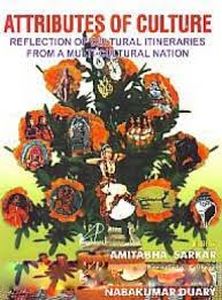
Contents: 1. Introduction/Amitabha Sarkar. 2. Anthropological understanding of arts and crafts/Jayanta Sarkar. 3. Kathak-the performing art form of Indian heritage/Samira Dasgupta. 4. Pandwani: a folk theatre form of Mahabharata/Niranjan Mahawar. 5. Mask: an element of culture/A.K. Chatterjee. 6. Toda myths: an ethnographical enquiry/Sibir Ranjan Das. 7. Splendid cultural signatures and architectural monuments: temple architecture of Bengal/Samira Dasgupta. 8. Terracotta art of Bengal/Atul Chandra Bhowmick. 9. The Charan folk songs in Caurashtra of Gujarat: story of worship of mother goddess cult/Arup Roy. 10. Engraved wooden comb: a symbol of love and an excellence of least known tribal community of Bastar/Amitabha Sarkar and Samira Dasgupta. 11. Creativity and excellence in Gainabori in rural women of coastal Bengal/Nabakumar Duary. 12. Sankha or conch shell craft of Bishnupur (West Bengal)/Samira Dasgupta. 13. Tattooing in Central India/Niranjan Mahawar. 14. Anthropology of tribal paintings of Rajasthan/Tilak bagchi and Pritish Chaudhuri. 15. Dush Avatar Tash- artists and art form and its propagation through tourism/Samira Dasgupta and Amitabha Sarkar. 16. The art of Shola; a living traditional craft of West Bengal/S. Chanda. 17. Madhubani folk painting commercialisation, colour and significance/Nabakumar Duary. 18. Ghadwa art and artisans of Bastar in the light of development/Samira Dasgupta. 19. Serpai: an innovative folk craft of an obscure village of Birbhum, West Bengal/Sumahan Bandyopadhyay. 20. Chtrakaras of Odisha with special reference to Puri district/Chumki Piplai. 21. Kantha in Bengal: an art of stitching/Nabakumar Duary. 22. Puppetry: an ancient form of performing art/D.K. Samanta. 23. Urskul: the memorial pillar: an attribute of dwindling tribal culture of Bastar/Amitabha Sarkar.
India has a rich cultural heritage. Culture embodies the ideas and norms of a group. It is the sum-total of its ideal patterns and norms of behavior. Culture fulfills those ethical and social needs of the groups that are ends in themselves. Culture possesses an order and system. Art is a manifestation or expression of inner thought which is obviously a creative in nature. It is a kind of visual communication carrying the cognitive meaning of the object. This art form is either tangible or intangible which are a kind of cultural attributes of an ethnic group. In the present treatise we chiefly concentrate upon both tangible art forms which one can observe, can even touch the object/specimen and also, the intangible art which one can feel through his/her empathy like- folklore, myth, riddle even the performing art forms etc. Often some tangible art form become a craft to a particular community through which they are identified, such as, bell metal works by Kansari, conch Shell work by Sankhari, painting on Pat by Patua and Dokra works by Gadwa community, Gayna bari, Dush avatar tash, Madhubani painting, puppetry, wood engraving, tattoo, basket weavers especially among Riang of Tripura etc. Among the intangible art forms, Kathak, Charan folk song, Pandawani, Toda myth etc. are the key attributes of our culture and our country’s heritage is enriched by these least known art forms.
Man learns his behavior from his immediate environment and this forms the basis and develops the traits of his culture. Thus culture is a system of learned behavior shared by and transmitted among the members of a group. Man begins to learn it since his birth. The present volume is an assembly of number of articles of various least known art forms of - ‘a multi-cultural nation-India’. This book can help students, NGO’s, planners cum local administrators to gain an insight into local cultural milieu which in turn can help them adapt a holistic approach for developmental programmes at micro levels.